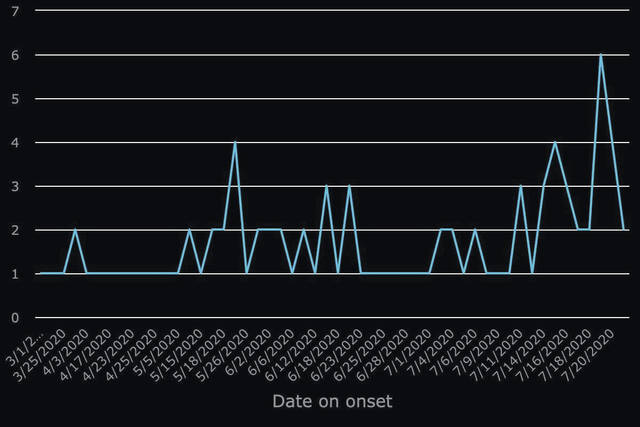
Highland County has had 96 lab-confirmed and probable COVID-19 cases — 15 of which resulted in hospitalization and one of which resulted in death as of Monday, according to the Ohio Department of Health (ODH).
On Friday, the Highland County Health Department reported that 69 patients had recovered, but it was monitoring a total of 117 people for COVID-19 symptoms.
As of Wednesday, July 22, Highland County had seen a total of 87 lab-confirmed and probable COVID-19 cases, 12 hospitalizations, and one death since the beginning of the pandemic, the Highland County Health Department stated in a Facebook post. Sixty patients had recovered.
The health department was also monitoring 103 people for symptoms.
According to the ODH, of the cases in Highland County as of Monday:
* 20 cases involved 60- to 69-year-olds, three of whom were hospitalized.
* 18 cases involved 40- to 49-year-olds, two of whom were hospitalized.
* 15 cases involved 70- to 79-year-olds, four of whom were hospitalized.
* 14 cases involved 50- to 59-year-olds.
* 12 cases involved 20- to 29-year-olds, one of whom was hospitalized.
* 9 cases involved 0- to 19-year-olds, one of whom was hospitalized.
* 7 cases involved 30- to 39-year-olds, one of whom was hospitalized.
* 1 case involved someone 80 years old or older, who was hospitalized and later died.
In an interview last week, Highland County Health Commissioner Jared Warner expressed concern for a potential increase in the number of hospitalizations in the county.
“Everyone wants to focus on the fatality rate — that’s where they want to end the conversation. People keep forgetting the hospitalization rates that tend to be associated with this,” Warner said. “When we look at a population like Highland County that, as far as we can tell, is pretty sheltered from feeling the effects of this virus, there are a lot of people who could potentially get sick.”
According to Warner, about 12 to 14 percent of confirmed COVID-19 cases result in hospitalization, which can overwhelm health care systems as providers continue to receive patients with non-COVID-related health issues as well.
“I’ve seen graphs all over Facebook too that say, ‘This is how many people live in Ohio, and this is the number of people who have been impacted — why are they making such a big deal about it?’ Part of the reason we’re making a big deal is that most of the people who have not been impacted have also not been exposed,” Warner said. “They have no immunity, and we have very little treatment available to us. There’s really no prevention — no vaccine or anything like that. We have to take it seriously because we know it has a higher hospitalization rate. It’s also nine to 10 times more deadly than the flu. It’s not something to panic about, but it does require a little bit of a different approach from a public health perspective.”
For more information visit coronavirus.ohio.gov.
Reach McKenzie Caldwell at 937-402-2570.


